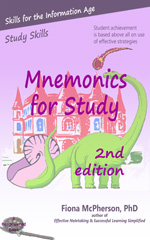The two types of first-letter mnemonics
First-letter mnemonics are, as their name suggests, memory strategies that use the initial letters of words as aids to remembering. This can be an effective technique because initial letters are helpful retrieval cues, as anyone who has endeavored to remember something by mentally running through the letters of the alphabet can attest to.
There are two types of first-letter mnemonic:
- acronyms: initial letters form a meaningful word;
- acrostics: initial letters are used as the initial letters of other words to make a meaningful phrase
ROY G. BIV is an acronym (for the colors of the rainbow), and Richard Of York Gives Battle In Vain is an acrostic for the same information.
Similarly, the acronym FACE is used to remember the notes in the spaces of the treble staff, and the acrostic Every Good Boy Deserves Fruit for the notes on the lines of the treble staff.
Here’s some more well-known ones. Some acronyms first:
MRS GREN — the characteristics of living things: Movement, Respiration, Sensitivity, Growth, Reproduction, Excretion, Nutrition.
BEDMAS — the order of mathematical operations: Brackets, Exponent, Division, Multiplication, Addition, Subtraction.
HOMES — the Great Lakes in the U.S.A.: Huron, Ontario, Michigan, Erie, Superior.
And some acrostics:
My Very Eager Mother Just Served Us Nine Pizzas — the order of the planets: Mercury, Venus, Earth, Mars, Jupiter, Saturn, Uranus, Neptune, Pluto.
Father Charles Goes Down And Ends Battle — the order of sharps in music
King Phillip Came Over From Great Spain — the order of categories in the taxonomy of living things: Kingdom, Phylum, Class, Order, Family, Genus, Species
It’s likely that you’ll know very different acrostics for these same items. That’s one difference between acronyms and acrostics — the same acronyms are likely to be known to everyone, but acrostics are much more varied. The reason’s not hard to seek — clearly there are infinite possibilities for acrostics, but very very limited possibilities for acronyms.
This means, of course, that opportunities to use acronyms are also very limited. It is only rarely that the initial letters of a group of items you wish to learn will form a word or series of words or at least a pseudo-word (a series of letters that do not form a word but are pronounceable as one — like BEDMAS).
Nothing is going to make MVEMJSUNP (the order of planets) memorable in itself, even if you break it up into vaguely intelligible bits, like this: M.V. Em J. Sun P. (although that does help — say it and you’ll see why).
Acrostics, on the other hand, are easy to create, and any string of items can be expressed in that form. For example:
My Very Earnest Mother Jumped Seven Umbrellas Near Paris
Men View Enemies Mildly Juiced Since United Nations Party
Michael Voted Every May Judiciously Since Union Newsletters Plunged
Problems with first-letter mnemonics
Medical students are probably the group who use first-letter mnemonics most. Here’s a medical example that demonstrates a common problem with first-letter mnemonics:
On Old Olympia’s Towering Top A Finn And German Vault And Hop
This is a mnemonic for remembering the cranial nerves: olfactory, optic, oculomotor, trochlear, trigeminal, abducens, facial, auditory, glossopharyngeal, vagus, accessory, and hypoglossal. Of course, reiterating my earlier point, the mnemonic wouldn’t help most of us remember this information, because we don’t know these names. But there’s another problem with this acrostic: three Os, two Ts and three As. This is a particular problem when the purpose of the acrostic is to remind you of the precise order of items, for obvious reasons. In such a case, you need to use words that distinguish between similar items. Thus, a better acrostic for our medical students might be:
Oliver Operates Occasional Tropical Tricks Absurdly For Australian Gymnasts Vaulting Actual Helicopters
Except that the traditional acrostic does have two big advantages that make it a much more memorable sentence: rhythm and rhyme. Say them both aloud, and you’ll see what I mean.
Let’s try for an acrostic that contains the vital information and is memorable.
Oliver Opens Oceans; Tropical Trips Abet; Fabulous Authors Gushing; Violent Acts Hinted
Okay, this isn’t very good either, and it took a little while to come up with. I’ve tried to distinguish the same-initial terms by including the second letter. The problem is, this additional constraint makes a big difference in limiting the possibilities.
Also, of course, creating an acrostic with rhyme and rhythm requires a great deal more work than simply creating a meaningful sentence. Rhyme and rhythm do, however, render the acrostic considerably more memorable.
In fact, were I trying to memorize the 12 cranial nerves, I wouldn’t use a first-letter mnemonic. Let us consider what you need to learn:
- the names of each nerve
- the function of each nerve
- the order of each nerve
The cranial nerves are not simply in a particular order; they are numbered. This immediately suggests the appropriate mnemonic: the pegword mnemonic. And the need to remember some rather strange names, and associate this information with function, suggests another useful mnemonic: the keyword mnemonic.
Excerpted from Mnemonics for Study
